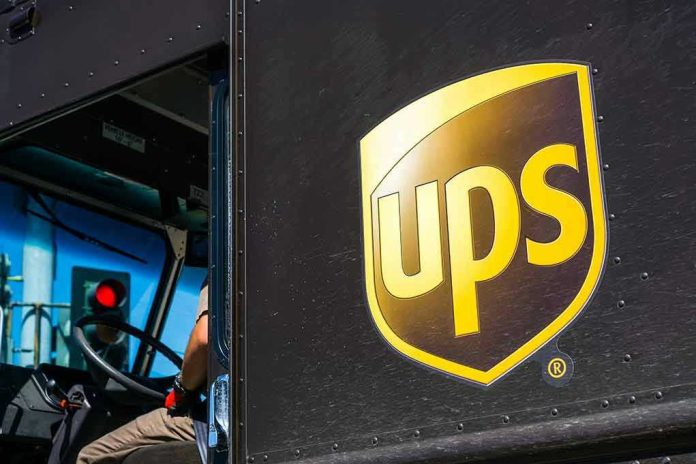
UPS’s 2025 workforce overhaul shattered expectations, erasing 34,000 jobs and closing 93 sites—raising urgent questions about the future of American labor and logistics as automation and strategic pivots redefine the industry’s landscape.
Story Snapshot
- UPS cut 34,000 jobs and closed 93 facilities in 2025, far exceeding initial forecasts.
- Automation, cost pressures, and a reduced Amazon partnership fueled the largest restructuring in UPS’s history.
- The company aims for $3.5 billion in annual savings, with the lion’s share of packages routed through automated hubs.
- Labor relations, long-term competitiveness, and the ripple effects on communities remain unresolved.
UPS’s Historic Restructuring: Numbers That Speak Volumes
UPS eliminated 34,000 jobs in 2025, topping the original estimate of 20,000 and marking the largest workforce reduction in the company’s century-plus history. Management and operational roles vanished as the company closed 93 facilities, a move that outpaced even their most aggressive forecasts. The cost-cutting drive is projected to save $3.5 billion this year, reshaping UPS’s operations from the ground up. Behind the headline numbers lies a deliberate strategy: streamline, automate, and break from reliance on powerhouse clients like Amazon, whose own logistics ambitions have eroded UPS’s parcel volumes by more than a fifth over the past year.
UPS cuts 34,000 jobs in the year to date as its turnaround continues https://t.co/wR4BrhvgAR
— Aki Paloheimo (@OmglolU) October 28, 2025
CEO Carol Tomé and CFO Brian Dykes spearheaded the turnaround, orchestrating a cascade of layoffs and voluntary buyouts, particularly targeting drivers. By August 31, 2025, most buyouts were complete, accelerating the shift toward automated package handling. In Q3 earnings, Tomé hailed the buyouts as a “success” and Dykes described the overhaul as “the largest network reconfiguration in our history.” These statements underscore a hard-nosed approach to restoring profitability and adapting to competitive pressures that have intensified since the Teamsters union secured a costly new contract in 2023.
Automation and Amazon: The Twin Engines of Change
Automation is now at the core of UPS’s network strategy, with 66% of packages expected to be processed through automated facilities by year’s end. This pivot is a direct response to shrinking margins and changing e-commerce dynamics. Amazon’s move to internalize more of its own logistics slashed UPS’s Amazon package volume by 21.2% in Q3 alone, forcing the company to reconsider its dependence on big-ticket clients. The result: a leaner, more technologically advanced operation, but one that leaves thousands of workers displaced and communities grappling with lost jobs and shuttered hubs.
The logistics sector’s embrace of automation mirrors trends seen across manufacturing and retail, where robotics and software eat away at traditional roles. For UPS, the gamble is clear: invest in technology now to stay competitive, even if it means short-term pain for employees and local economies. Investors have responded favorably, sending UPS shares up 12% after the Q3 report, but the long-term impact on service quality and labor relations remains to be seen.
The Human Cost and Strategic Fallout
Displaced workers face an uncertain future, especially in towns anchored by now-closed UPS facilities. Remaining employees shoulder heavier workloads or anxiety about further cuts. The Teamsters union, representing a significant share of UPS’s workforce, is left negotiating the fallout from what labor advocates call an unprecedented wave of layoffs. The economic ripples stretch beyond the company: local businesses lose customers, municipalities lose tax revenue, and families lose stable incomes at a time when automation is accelerating across the supply chain.
UPS’s decision to cut ties with less profitable Amazon business signals a new era for logistics providers. Industry analysts argue that this aggressive restructuring sets a precedent, potentially triggering similar moves at FedEx, DHL, and others. Some experts warn of risks if service standards falter or labor unrest intensifies, especially as American logistics companies balance efficiency with the social costs of automation-driven layoffs. Academic observers highlight the tension between technological progress and the erosion of unionized jobs—an issue likely to attract scrutiny from policymakers and labor advocates in the months ahead.
Sources:
Business Insider: UPS cut 34,000 jobs in 2025, more than expected
Supply Chain Dive: UPS layoffs, driver buyouts Q3 2025
Supply Chain Digital: UPS cuts 34,000 jobs
Business Chief: UPS cuts 34,000 jobs













